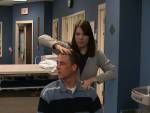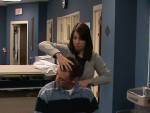Cervical rotation lateral flexion test: Difference between revisions
m (Text replace - 'Read more.' to ' ') |
m (Visual edit.) |
||
| (21 intermediate revisions by 7 users not shown) | |||
| Line 2: | Line 2: | ||
'''Original Editor '''- [[User:Sarah McBride|Sarah McBride]] | '''Original Editor '''- [[User:Sarah McBride|Sarah McBride]] | ||
''' | '''Top Contributors''' - {{Special:Contributors/{{FULLPAGENAME}}}} | ||
</div> | </div> | ||
== | == Purpose == | ||
The test | The purpose is to test for the presence of 1st rib hypomobility in patients with brachialgia with or without radicular pain as well as [[Thoracic Outlet Syndrome (TOS)|thoracic outlet syndrome]]. <ref name="thoracic outlet">Lindfren K-A, Leino E, Hakola M, Hamberg J. Cervical spine rotation and lateral flexion combined motion in the examination of the thoracic outlet. Arch Phys Med Rehabil 1990; 71: 343-344.</ref><ref>Lindgren KA, Leino E, Manninen H. Cervical rotation lateral flexion test in brachialgia. Archives of physical medicine and rehabilitation. 1992 Aug 1;73(8):735-7. | ||
</ref> | |||
== Technique == | |||
* The test is performed with the patient in a sitting. | |||
* The cervical spine is passively and maximally rotated away from the side being tested. | |||
* While maintaining this position, the spine is gently flexed as far as possible moving the ear toward the chest. | |||
* A test is considered positive when the lateral flexion movement is blocked. | |||
The reference standard is the presence of rib hypomobility on cineradiography in subjects with brachialgia. | |||
<br> | |||
<div class="row"> | |||
<div class="col-md-2"> [[Image:CRLF1.jpg|center|200px|thumb|Cervical rotation]]</div> | |||
<div class="col-md-4"> [[Image:CRLF2.jpg|center|200px||thumb|Lateral flexion of the cervical spine toward the chest]]</div> | |||
</div> | |||
== Evidence == | |||
< | Diagnostic accuracy and reliability are concluded as 0.84 and 1.0 Kappa values respectively in a study. <ref name="users guide">Flynn TW, Cleland JA, Whitman JM. Users' guide to the musculoskeletal examination: fundamentals for the evidence-based clinician. United States; Evidence in motion: 2008.</ref> | ||
Although it is frequently used to decide whether to perform a thrust manipulation targeting the first rib, it does not help predict who will benefit from upper rib manipulation. <ref>Koppenhaver SL, Morel T, Dredge G, Baeder M, Young BA, Petersen EJ, Fernández-de-Las-Peñas C, Gill N. The validity of the cervical rotation lateral flexion test in predicting benefit after manipulation treatment to the first and second rib. Musculoskeletal Science and Practice. 2022 Dec 1;62:102629. | |||
</ref> | |||
== Resources == | |||
A video on how to perform the cervical rotation lateral flexion (CRLF) test:{{#ev:youtube|uDz0ZWrupGY}}<ref>IAOMUSVIDEO. Lindgren: CRLF test. Available from: https://www.youtube.com/watch?v=uDz0ZWrupGY</ref> | |||
== References == | == References == | ||
<references /> | <references /> | ||
[[Category:Assessment]] | |||
[[Category:Cervical Spine]] | |||
[[Category:Cervical Spine - Assessment and Examination]] | |||
[[Category:Special_Tests]] | |||
[[Category:Musculoskeletal/Orthopaedics|Orthopaedics]] | |||
[[Category:EIM_Residency_Project]] | |||
[[Category:Cervical Spine - Assessment and Examination]] | |||
[[Category:Cervical Spine - Special Tests]] | |||
Latest revision as of 17:25, 16 September 2023
Original Editor - Sarah McBride
Top Contributors - Sarah McBride, Sehriban Ozmen, Admin, Kim Jackson, Evan Thomas, Laura Ritchie, Rachael Lowe, Naomi O'Reilly and WikiSysop
Purpose[edit | edit source]
The purpose is to test for the presence of 1st rib hypomobility in patients with brachialgia with or without radicular pain as well as thoracic outlet syndrome. [1][2]
Technique[edit | edit source]
- The test is performed with the patient in a sitting.
- The cervical spine is passively and maximally rotated away from the side being tested.
- While maintaining this position, the spine is gently flexed as far as possible moving the ear toward the chest.
- A test is considered positive when the lateral flexion movement is blocked.
The reference standard is the presence of rib hypomobility on cineradiography in subjects with brachialgia.
Evidence[edit | edit source]
Diagnostic accuracy and reliability are concluded as 0.84 and 1.0 Kappa values respectively in a study. [3]
Although it is frequently used to decide whether to perform a thrust manipulation targeting the first rib, it does not help predict who will benefit from upper rib manipulation. [4]
Resources[edit | edit source]
A video on how to perform the cervical rotation lateral flexion (CRLF) test:
References[edit | edit source]
- ↑ Lindfren K-A, Leino E, Hakola M, Hamberg J. Cervical spine rotation and lateral flexion combined motion in the examination of the thoracic outlet. Arch Phys Med Rehabil 1990; 71: 343-344.
- ↑ Lindgren KA, Leino E, Manninen H. Cervical rotation lateral flexion test in brachialgia. Archives of physical medicine and rehabilitation. 1992 Aug 1;73(8):735-7.
- ↑ Flynn TW, Cleland JA, Whitman JM. Users' guide to the musculoskeletal examination: fundamentals for the evidence-based clinician. United States; Evidence in motion: 2008.
- ↑ Koppenhaver SL, Morel T, Dredge G, Baeder M, Young BA, Petersen EJ, Fernández-de-Las-Peñas C, Gill N. The validity of the cervical rotation lateral flexion test in predicting benefit after manipulation treatment to the first and second rib. Musculoskeletal Science and Practice. 2022 Dec 1;62:102629.
- ↑ IAOMUSVIDEO. Lindgren: CRLF test. Available from: https://www.youtube.com/watch?v=uDz0ZWrupGY








